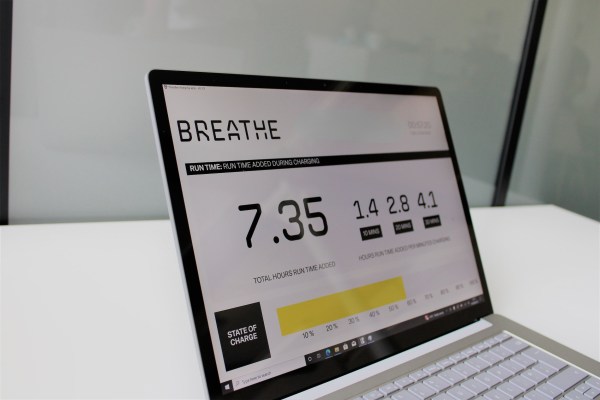Lithium-ion batteries have been making steady progress over the past decade, boosting energy density while also falling in price. But Ian Campbell thinks that today’s designs, no matter how advanced, are still leaving something on the table.
“There’s a gobsmackingly enormous amount of performance still to be unlocked from existing materials and chemistries,” he told TechCrunch+.
Campbell has spent much of the last decade studying how batteries charge and why they fail, two characteristics of every battery that are tightly bound. In the process, he and his colleagues at Breathe Battery Technologies have developed a bit of software that can be slipped into just about any lithium-ion battery in use today, endowing it with either faster charging speeds or greater longevity.
The startup offers two different products, Charge and Life. The former reduces charging times by a significant measure. The company’s code shaved 27% off the 0% to 80% charging time for a standard battery type used in warehouse robots, for example. The latter improves the longevity of the battery. In the case of the Oppo Reno8 Series phones, the company says its software significantly reduces battery degradation, hitting 80% capacity after four years instead of two.
“Customers get a better, longer-lasting laptop or car. If you’re the OEM that sells it to us, you have a more sustainable product, you have better warrantability, you have less balance sheet risk,” said Campbell, who is co-founder and CEO at Breathe.
The real prize is the automotive sector. Already, 60% of the lithium-ion batteries produced in the world are destined for electric vehicles, according to Allied Market Research. In the coming years, that share is likely to grow further even as the sector continues to expand rapidly.
Breathe said that it’s currently working with Rimac and Cosworth, and Campbell said that conversations with other car companies were “very far along.” “We’re making a lot of headway in automotive, and I’m very excited.”
Breathe recently closed a competitive $10 million Series A led by Lowercarbon Capital with participation from Speedinvest, TechCrunch+ has exclusively learned.
The startup’s software can run on industry standard microcontrollers that oversee the charging and discharging of a battery in an EV or an electronic device.
Most batteries today, Campbell said, come with spec sheets — lookup tables, essentially — that tell device manufacturers how to treat the battery at various stages in its life. “What happens then is that all of the battery capability when it’s fresher and newer is underutilized,” he said. “But then after that point in time, the control strategy is too aggressive for the battery health that’s now degraded. That control strategy starts driving it into this positive feedback loop that’s damaging the battery. It’s pushing it too hard for its age, essentially.”
Instead, Breathe has developed a range of models tailored to describe what’s happening inside various lithium-ion chemistries. By studying the electrical signals coming out of the cells, the software is able to adjust the battery’s performance more deftly than existing approaches.
As Campbell tells it, Breathe’s software is pretty lightweight. On a typical battery management system, “there’s about 99.9% of the software that we don’t touch,” he said.
Despite that relatively small code footprint, Campbell thinks that software like Breathe’s and others’ suggest that batteries are about to enter a new era. “There is a huge amount of opportunity for batteries to not become just hardware but become software-defined devices,” he said.
Battery manufacturers would probably object to that, pointing to the significant strides they’ve made to date and those that are already in the pipeline. Silicon anodes, solid state chemistries and more all promise to continue improving energy density in the coming years.
Still, Campbell and Breathe have a point. Software will almost always advance faster than materials science.
Luckily for battery manufacturers, Breathe’s approach is complementary to many advances in cell chemistries. The real race is to boost energy density to give mobile devices more uptime or EVs more range. If another company can offer faster charging times or improved longevity “for free,” it makes sense for OEMs to hop onboard.
Where does Breathe go from here? If its software proves invaluable to one company or another, the startup could become an acquisition target. Device manufacturers like Oppo, Samsung or Apple might be interested if Breathe’s promises of improved charging times hold up in the coming years. Automakers, which tend to be happier working with a range of suppliers, are less likely to pursue an acquisition. Battery manufacturers like Northvolt could be a different story, though. They might be interested in offering Breathe’s software products as a way to boost margins and move higher up the value chain.
It’s also entirely likely that Breathe could soldier on as an independent concern, catering to both tech and automotive customers. If it finds a wide range of customers and its valuation takes off with subsequent rounds, that seems very possible. Which path will Breathe follow? That’ll depend on which of its customers has the most to gain — or which offers the richest returns.
